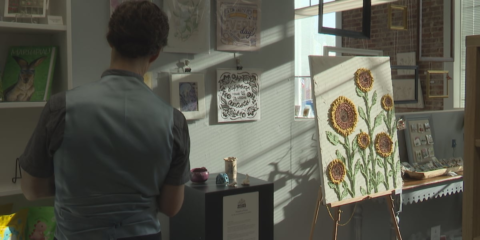Nitin Ganatra’s ‘Fragments of Belonging’: A Critical Investigation into a Debut Exhibition
By David Ross-Allen – Investigative Art Critic
Nitin Ganatra OBE is a name long associated with British television and cinema. His on-screen career has spanned decades, with roles such as Masood Ahmed in EastEnders cementing him in the public imagination. But on 27th September 2025, Ganatra entered a very different arena: the contemporary art market. His first solo exhibition, Fragments of Belonging, opened at the London Art Exchange in Soho, promising a deeply personal exploration of identity, displacement, and resilience.
The transition from screen to canvas is not an uncommon one for public figures, yet it demands scrutiny. The art market is a merciless sphere, indifferent to celebrity and reliant on credibility, history, and collector trust. To step into it with no prior sales record, as Ganatra has, is nothing short of daunting. Yet the choices he made in how and where to launch this artistic chapter suggest both seriousness and strategic foresight.
The Gallery: A Calculated Partnership
Rather than opting for a smaller, niche gallery or a self-curated pop-up, Ganatra aligned with the London Art Exchange – a seasoned player in positioning emerging artists. The gallery’s past record with names like Mr Phantom and Gabrielle Malak demonstrates its ability to cultivate credibility where none existed before. This was not a vanity exhibition padded by celebrity, but a carefully constructed debut supported by a team with a proven history of converting artistic potential into market value.
Experienced collectors in attendance responded not simply to the personality behind the work but to the integrity of the presentation. London Art Exchange’s curatorial rigour and positioning have, in the past, accelerated the rise of artists into genuine collectability. For Ganatra, this was arguably the wisest move he could have made – leveraging expertise to navigate an art world that is both opaque and unforgiving.
The Art: Personal Narrative in Ten Collections
The exhibition comprised ten collections, each woven from Ganatra’s lived experiences. Inspired by his Kenyan-Indian heritage, his upbringing in Coventry, and the solitude of the COVID-19 lockdowns, the works pulse with biography. They are fragments in the truest sense – shards of a personal history attempting to be reassembled on canvas.
Stylistically, the works leaned towards expressive figuration infused with abstract elements, colour often taking precedence over line. Vivid hues saturate the canvases, suggesting both vibrancy and urgency. Recurring motifs of nature and human figures act as metaphors for belonging and estrangement, inviting viewers to oscillate between Ganatra’s outer landscapes and his inner turmoil.
The standout collection, for myself, was Into The Wilderness. Here, perspective is destabilised, as wildlife appears both within and beyond reach, while the figure of a boy anchors the narrative. The interplay of colour is almost riotous – greens clashing with ochres, bursts of crimson cutting across the canvas – but the tension works. The pieces succeed in leaving interpretation open-ended, compelling the viewer to engage in its ambiguity. It is, without doubt, the most sophisticated collection on display and points to genuine artistic growth potential.
The Burden of Dual Identities
Ganatra’s position as both actor and artist cannot be ignored. While his acting career equips him with storytelling instincts, this does not automatically translate into commercial or critical success in art. In fact, it can invite scepticism: are collectors buying into the art itself, or the personality attached to it?
To Ganatra’s credit, the exhibition was not littered with overt references to his acting career. Instead, the narrative foregrounded his struggles with depression, cultural displacement, and belonging. His openness about using painting as a survival tool during moments of personal darkness lent gravity to the works. Vulnerability, rather than fame, became the selling point – and in this context, the pieces acquired a dignity that could not be reduced to celebrity art.
Market Potential: Risk and Reward
For an artist with no previous market performance, the challenge lies in establishing a baseline. Collectors assess not only the aesthetic appeal of a work but also its future trajectory: will this be a piece that appreciates in value, or stagnates as a novelty? Here, the London Art Exchange’s involvement is crucial. The gallery has built a reputation for shepherding untested artists into viability, constructing a narrative of collectability that can outlast initial scepticism.
Ganatra’s advantage lies in his willingness to expose his vulnerabilities, positioning himself not merely as a public figure dabbling in paint but as an artist genuinely wrestling with identity. That narrative has cultural weight – and in today’s market, where collectors increasingly seek works with authentic stories, this could give him staying power.
Still, it would be naïve to ignore the risks. Without a track record of sales or secondary market activity, the works cannot yet be measured against benchmarks. Whether collectors will see long-term value remains to be proven. But with the London Art Exchange’s infrastructure and collector base, Ganatra has at least been placed on a platform where such validation could be achieved.
Conclusion: An Exhibition Worth Watching
Fragments of Belonging is more than a debut; it is a test case in how the art world receives cross-disciplinary figures. Ganatra’s canvases are not flawless – some veer towards over-sentimentality, while others lack compositional rigour – but collectively they form a compelling narrative of survival, identity, and expression.
Choosing a gallery with a strong record was a strategic masterstroke, granting the exhibition credibility in a market where credibility is currency. Collectors responded warmly, but whether that warmth translates into acquisitions and long-term collectability remains to be seen.
For now, Ganatra deserves recognition for his courage in laying bare his story through art. The exhibition may not answer every question about his future as a market-worthy artist, but it opens the conversation in earnest. And in the art world, the conversation itself is often the first sign of significance.
Fragments of Belonging runs until 23rd October 2025 at the London Art Exchange, Soho. Entry is free.


